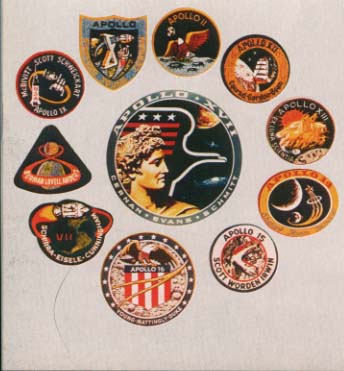Annual 1975
| 'germs' might spread un- controllable epidemics. And gone are the fears that man might be unable to survive outside the planetary en- vironment. This was man's greatest step forward in the whole history of civili- sation. A step with the codename--Apollo. THE MANNED MISSIONS Apollo 7. October 11-21, 1968. Schirra, Eisele and Cunningham make first 3-man flight. 163 Earth orbits. Apollo 8. December 21-27, 1968. Borman, Lovell and Anders come within 112 kilometers of Moon. Apollo 9. McDivitt, Scott and Schweickart orbit Earth 151 times in 10 days. March 3-13, 1969. |
 |
| The wild desolation of a Lunar landscape as Astronauts from Apollo 16 tour the surface. And below, the distinctive badges of the eleven manned Apollo missions.  |
Apollo 10. May 18-26, 1969. Stafford, Young and Cernan make 1.5 Earth orbits, 31 Moon orbits. Stafford and Cernan fly lunar module to within 15 kilometres of Lunar surface. Apollo 11. Man's first landing on the Moon. 0256 hrs. GMT, July 21, 1969. Collins, Armstrong and Aldrin. Apollo 12. November 14-24, 1969. Conrad, Gordon and Bean. Conrad and Bean make pinpoint landing at Ocean of Storms. Apollo 13. April 11-17, 1970. Lovell, Swigert and Haise avert disaster through on-board explo- sion of oxygen tank. Return to Earth. Apollo 14. Jan. 31-Feb. 9, 1971. Shepard and Mitchell on Moon for nearly 34 hours, while Roosa re- mains in orbit. Apollo 15. First use of Moon Car. July 26-August 7, 1971. Scott, Irwin and Worden. Apollo 16. Young, Mattingly and Duke. Young and Duke live on Moon for three days. April 16-27, 1972. Apollo 17. Cernan, Evans and Schmitt. December 7-19, 1972. The programme closes. The end of the beginning . . . |